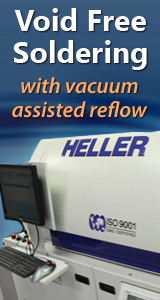Printed Circuit Board Assembly & PCB Design Forum
SMT electronics assembly manufacturing forum.
- SMTnet
- »
- Electronics Forum
- »
- Best/Common Practice in Blank PCB QC
Best/Common Practice in Blank PCB QC
![]() I would appreciate any feedback that can be provided regardi...
- Feb 21, 2003
by
George Henning
I would appreciate any feedback that can be provided regardi...
- Feb 21, 2003
by
George Henning
![]()
![]()
![]() Hi
"PCB blank quality. "
I am not sure what the word b...
- Feb 21, 2003
by
Hi
"PCB blank quality. "
I am not sure what the word b...
- Feb 21, 2003
by
![]()
![]()
![]() Hi
"PCB blank quality. "
I am not sure what the word b...
- Feb 21, 2003
by
Hi
"PCB blank quality. "
I am not sure what the word b...
- Feb 21, 2003
by
![]()
![]()
![]() We section no bare boards at incoming. If we have a problem...
- Feb 23, 2003
by
davef
We section no bare boards at incoming. If we have a problem...
- Feb 23, 2003
by
davef
![]()
![]()
![]() "Blank" means "bare board". Gray beards used this expressio...
- Feb 23, 2003
by
davef
"Blank" means "bare board". Gray beards used this expressio...
- Feb 23, 2003
by
davef
![]()
![]()
![]() Hey
No fair Davey F, I got a grey beard and I don't use o...
- Feb 23, 2003
by
Hey
No fair Davey F, I got a grey beard and I don't use o...
- Feb 23, 2003
by
![]()
![]()
![]() YiEng, MA/NY DDave,
Look at:
* Description on first item...
- Feb 24, 2003
by
davef
YiEng, MA/NY DDave,
Look at:
* Description on first item...
- Feb 24, 2003
by
davef
![]()
![]()
![]() "We visually inspect and check solderability at incoming."
...
- Feb 25, 2003
by
"We visually inspect and check solderability at incoming."
...
- Feb 25, 2003
by
![]()
![]() I don't know the precise scheme, but it goes something like ...
- Feb 25, 2003
by
davef
I don't know the precise scheme, but it goes something like ...
- Feb 25, 2003
by
davef
![]()
![]()
![]() OK. Let's turn this up a notch.
How do you qualify [cert...
- Feb 25, 2003
by
davef
OK. Let's turn this up a notch.
How do you qualify [cert...
- Feb 25, 2003
by
davef
![]()
![]()
![]() Hi
UNCLE!!!
UNCLE!!!
You know maybe I do remember thi...
- Feb 25, 2003
by
Hi
UNCLE!!!
UNCLE!!!
You know maybe I do remember thi...
- Feb 25, 2003
by
![]()
![]()
![]() One easy and often over looked step is to call out IPC-6012A...
- Feb 28, 2003
by
Kevin Facinelli
One easy and often over looked step is to call out IPC-6012A...
- Feb 28, 2003
by
Kevin Facinelli
![]()
![]()
![]() Hi
You are right. I guess some of us missed this point in...
- Feb 28, 2003
by
Hi
You are right. I guess some of us missed this point in...
- Feb 28, 2003
by
![]()
![]()
![]() Hi All,
Thanks for the helpful discussions on this. We're w...
- Mar 11, 2003
by
George Henning
Hi All,
Thanks for the helpful discussions on this. We're w...
- Mar 11, 2003
by
George Henning
![]()
![]()
![]() Hi
You are a young guy yet, I bet!
No fair with that t...
- Mar 11, 2003
by
Hi
You are a young guy yet, I bet!
No fair with that t...
- Mar 11, 2003
by
![]()
- SMTnet
- »
- Electronics Forum
- »
- Best/Common Practice in Blank PCB QC







